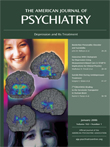Aripiprazole-Induced Movement Disorder
To the Editor: Aripiprazole is a dopamine D2 partial receptor agonist (1). Trials have shown rates of extrapyramidal side effects similar to those of placebo administration, as seen with other atypical antipsychotic agents (1). Some case reports have found that atypical antipsychotics may even be helpful in treating tardive dyskinesia (2, 3). Although the occurrence of extrapyramidal symptoms seems to be less frequent with atypical antipsychotics, it is important to note that these effects can still occur. To our knowledge, only one case of aripiprazole-associated dyskinesia has been reported (4). We report a case of pseudoparkinsonism and rabbit syndrome that occurred in an antipsychotic-naive patient during treatment with aripiprazole.
Ms. A was a 27-year-old woman diagnosed with bipolar I disorder. Before she received care through our clinic, her condition was maintained with 150 mg/day of extended-release bupropion, 100 mg/day of lamotrigine, and 75 mg/day of extended-release venlafaxine. She had an emergence of manic symptoms and was administered aripiprazole, 10 mg/day. Ms. A had never been treated with an antipsychotic in the past. One month later, her dose of aripiprazole was increased to 20 mg/day. During the course of the next month, she was tapered from lamotrigine and venlafaxine to consolidate her drug regimen. She was seen for follow-up, where she complained of muscle stiffness and tongue movements that had grown increasingly worse over the last 2 months. She was observed by her outpatient psychiatrist to have muscle rigidity, a masked face, a shuffling gait, and orofacial movements consistent with rabbit syndrome.
It was decided to taper the aripiprazole and start ziprasidone, 60 mg b.i.d., along with benztropine, 1 mg b.i.d. Ms. A was seen 5 days later with a marked improvement in symptoms. She had no orofacial movements, decreased muscle rigidity, and only a slight tremor. At this visit, aripiprazole was completely stopped, and ziprasidone was increased to 80 mg b.i.d. Two weeks later, Ms. A was seen with no muscle rigidity or orofacial movements. Benztropine was discontinued, and her condition was maintained with ziprasidone without any reemergence of symptoms. When we evaluated these events with the probability scale of Naranjo et al., the case was ranked as a probable adverse drug reaction (5).
This case illustrates that the risk of developing extrapyramidal symptoms is still present, even with the newest of atypical antipsychotics. Clinicians should vigilantly monitor all patients for the emergence of symptoms, regardless of which antipsychotic a patient is receiving.
1. Gupta S, Masand P: Aripiprazole: review of its pharmacology and therapeutic use in psychiatric disorders. Ann Clin Psychiatry 2004; 16:155–166Crossref, Medline, Google Scholar
2. Duggal HS: Aripiprazole-induced improvement in tardive dyskinesia. Can J Psychiatry 2003; 48:771–772Medline, Google Scholar
3. Sachetti E, Valsecchi P: Quetiapine, clozapine, and olanzapine in the treatment of tardive dyskinesia induced by first generation antipsychotics: a 124-week case report. Int Clin Psychopharmacol 2003; 18:357–359Crossref, Medline, Google Scholar
4. Sajbel TA, Cheney EM, DeQuardo JR: Aripiprazole-associated dyskinesia. Ann Pharmacother 2005; 39:200–201Crossref, Medline, Google Scholar
5. Naranjo CA, Busto U, Sellers EM, Sandor P, Ruiz I, Roberts EA, Janecek E, Domecq C, Greenblatt DJ: A method for estimating the probability of adverse drug reactions. Clin Pharmacol Ther 1981; 30:239–245Crossref, Medline, Google Scholar



